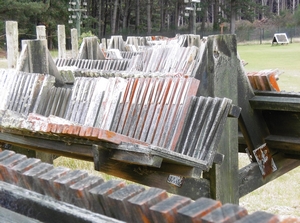Wood graveyard provides foundations for timber industry durability studies
IO2: Solid wood processing
 Scion’s Whakarewarewa graveyard is not the typical resting place. Originally established in 1947 when scientific research first commenced on campus, the wood field test site, or graveyard as it is better known, has become a national database for timber durability and product evaluation.
Scion’s Whakarewarewa graveyard is not the typical resting place. Originally established in 1947 when scientific research first commenced on campus, the wood field test site, or graveyard as it is better known, has become a national database for timber durability and product evaluation.The graveyard allows wood and wood products to be field tested in a high decay-hazard situation, over a lengthy period of time. It contains ground-contact stakes, poles and posts, as well as above-ground and simulated commodity tests such as decking, cladding and joinery. It also provides information about naturally durable species, and non-wood based products like wood composites and plastics.
The Whakarewarewa field test site is one of four Scion graveyards around New Zealand that, collectively, represent a variety of climate, soil types and ground contact hazards. The information derived from these graveyards is unique and irreplaceable, and provides a foundation for the timber industry.
Scion works with industry in New Zealand and internationally to test the durability of wood products and set national and international standards for good building practice. Graveyard testing is an integral part of a durability assessment, which starts with laboratory pure culture decay tests, then to accelerated fungal cellar tests, and ultimately to the in-service graveyard tests.
A preservative treated, or naturally durable, timber that performs satisfactorily at these sites is considered suitable for use throughout New Zealand. Currently, we are also testing products for clients in Germany, the Netherlands, USA and Australia.
“Existing wood product technologies are largely mature,” says Wood Durability Specialist Dr Tripti Singh. “Our graveyards allow the industry to grow and diversify value-added exports from forest resources.
“As a result of the proprietary technologies we develop through our wood protection research, the industry will be able to develop and export technologically differentiated high-value building and construction product streams.”
One such technology is a wood protection treatment made from natural bioactive compounds.
As Tripti explains, this technology responds to consumer demand for healthy living environments, and the regulatory demand for building and construction products that do not create an end-of-life disposal problem.
For the past six years, Tripti and the research team have been conducting an intensive screening programme from a range of sources, including agricultural and horticultural waste, essential oils, medicinal and native plant extracts, natural biocides and other compounds generally recognised as safe, such as food preservatives.
The team has identified a number of suitable bioactives, and further developed one into a water-based formulation for treating timber. Following successful laboratory trials to evaluate its antimicrobial activity and stability, long-term field trials have now been established for treated cladding, decking and exterior joinery at both the Whakarewarewa graveyard and the Oregon State University’s graveyard in Hawaii. These field trials will be assessed on an annual basis.
The team has also developed and validated a method of quantifying this novel bioactive in treated wood for quality assurance purposes.
Our graveyards are listed at IRG/WP (International Research Group on Wood Protection) website http://www.irg-wp.com/index.html
